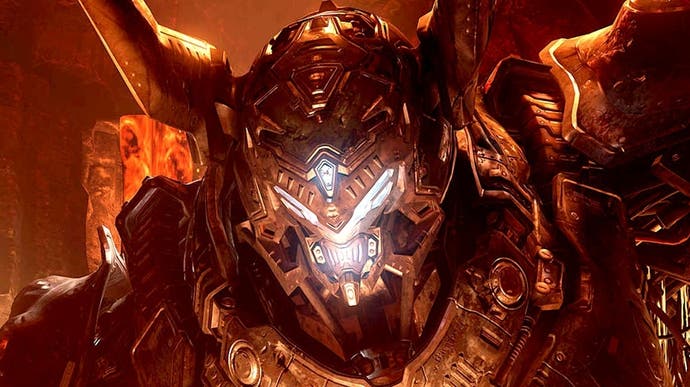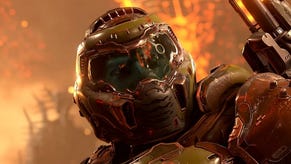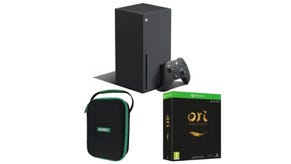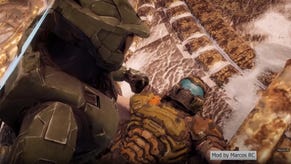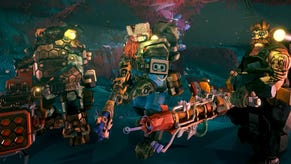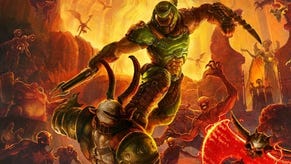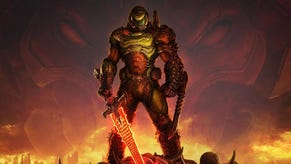Is Doom Eternal the most ambitious Switch port yet?
The id Tech 7 engine is designed to scale into next-gen - but can it run on a handheld console?
There's no question about it - Doom Eternal is a remarkably impressive technical achievement. The id Tech 7 engine delivers exceptionally high-quality visuals at a smooth 60 frames per second across the full range of PlayStation and Xbox consoles. We witnessed a boost in texture quality, geometry density and world scale. It's a game that really demonstrates the full potential of these machines, while laying the technological foundation for the next generation. In theory, this should make a potential Switch conversion of the game even more challenging than prior Panic Button ports of id Tech titles and yet, there's a good argument here in saying that this the talented developer's most impressive work yet.
Of course, by any virtually any measurable criteria - bar power consumption, of course! - the Switch rendition of Doom Eternal is the least preferable way to play the game. In fact, it calls to mind classic conversions like Quake for Sega Saturn. It was by far the least impressive version, yet the technological achievement in actually making it happen was simply immense. By extension, I can praise Panic Button's work here while knowing full well that it is best played on other systems. That's the key here - one can find such a port impressive and interesting while still acknowledging its shortcomings.
From my perspective, the focus of a port like this should always centre around recreating key aspects of the game in question while making intelligent cuts. Even with a reduction in visual quality, the game should retain its visual identity while offering performance characteristics that avoid spoiling the fun. If your port exhibits painfully long loading times, poor performance and a huge reduction of visual quality, it's not a good conversion. With its prior id Tech ports, I feel that Panic Button delivered good work in achieving these objects. Doom 2016 and the various Wolfenstein titles all very clearly deliver the gameplay and visual signature of the original versions albeit at a lower resolution and frame-rate. However, each port exhibited flaws including bad frame pacing and slowdown.
With Doom Eternal standing as the more technically ambitious game, then, I was pleasantly surprised with how it fares in comparison. The average resolution, for instance, is comparable to Doom 2016 but generally retains a higher pixel count than the most ambitious Wolfenstein: The New Colossus. In docked mode, Doom Eternal maxes out at 720p - just like those other titles - but can dip just under 540p when taxed. In comparison, Wolfenstein: The New Colossus dropped as low as 360p when docked, so this is an improvement. In portable mode, 360p is a possibility while 612p is the maximum pixel count.
In 2021, these low pixel counts are starting to feel somewhat incompatible with modern displays, especially on a 4K TV, which must surely be the major challenge the so-called Switch Pro is looking to address, but the presentation holds up more on the handheld screen, despite the big cuts in pixel count. And it is Doom Eternal. As I stacked up various scenes between Switch and Xbox One X, I found that the port captured the look of the original: overall scene complexity, lighting and effects are mostly intact. Yes, it's blurry as a result of the lower rendering resolution, but it's unmistakably Doom Eternal.
This comes back to the concept of intelligent cuts. Panic Button needed to find a way to replicate the look of the original game within the constraints of the platform. It's this need for such creative changes that I find most engaging. So what has changed? Well, aside from the resolution, the most significant departure lies in the textures. Basically, with id Tech 7, id left behind the remnants of Megatexture embracing more tried and true methods. This allows for greater high-frequency detail at close proximity - it's the reason why textures are so much sharper in Doom Eternal compared to Doom 2016.The downside is that the Switch just doesn't have the memory to support this approach without sacrificing asset quality and that's precisely what has happened here. Texture resolution is reduced throughout leading to less nuanced surfaces with more visible bilinear blur. Level of detail transitions are also more aggressive in spots and the volumetrics - as usual - are of a lower precision.
Another loss, from my perspective, is the complete elimination of per-object motion blur and other post-processing effects such as depth of field. This is perhaps the most significant cut as these elements not only help offset the reduced frame-rate but play a key role in defining the look of Doom Eternal. Without these effects, which were present in previous Panic Button conversions, the game winds up looking somewhat less impressive in motion.
Despite all this, the density and complexity of the maps themselves has been retained. Considering the sheer volume of geometry on display and the size of the map data, this is a remarkable achievement. It also ensures that the entirety of the game is intact. Animation quality is also retained as are the alembic animations used in certain areas. However, sometimes the graphical compromises do cut deep - at various points, Doom Eternal swings between impressive and noticeably less attractive depending on where you point your camera.
That said, the notion of getting a cutting edge game running on the Switch at all is still an achievement that's difficult to fully grasp and I feel that the team made the right calls in most places. The reduction in texture quality is a given but I appreciate that map complexity is intact. The Doom Eternal aesthetic has been achieved, by and large. It is visually superior to the prior Wolfenstein ports overall, I might argue. The sacrifices made are less distracting and it more closely matches the original console release. Really, the only major critique that I really found difficult to adjust to was the elimination of post-processing effects. With motion blur restored at the very least, the quality of the visuals would benefit tremendously. Of course, this has its own fixed cost so I can understand the decision to eliminate it - especially when performance is so solid.
As a reminder, Doom 2016 on Switch exhibited minor dips and significant frame pacing errors that robbed the game of fluidity while Wolfenstein 2 suffered from serious drops in performance during the game's larger battles. Miraculously, Doom Eternal outperforms all prior id Tech ports to Switch. The target frame-rate is, of course, reduced to 30 frames per second, as expected for the hardware, but unlike prior releases, Doom Eternal maintains this frame-rate most of the time. I played through around 50 per cent of the entire game content and found only one area with any noticeable drops to the target frame-rate - which is a huge improvement over prior ports. Mobile mode isn't quite as solid overall, but still holds up really well - the main compromise being letterboxed, locked 20fps cutscenes. Regardless, getting Doom Eternal to work at all is a minor miracle and to see it play out on a handheld with a ridiculously low power budget is truly remarkable.
So what's the takeaway here? Well, it's an interesting situation. When we discuss Switch ports, inevitably, there is a group of people that don't fully understand the conclusions drawn and why wer're impressed by what is a palpably compromised effect - but it's really quite simple. The Switch simply isn't comparable to last-generation consoles in terms of performance due to its portable nature. When judging ports to any platform, the difference between the original and target platforms must be defined - and that's why I believe Doom Eternal on Switch is a generally excellent conversion. Is it the best current-gen port yet? Well, the work carried out on The Witcher 3 is certainly up there, but this is definitely a phenomenal translation of what is one of the most technologically advanced engines on the market.
Not only that, it's clearly some of the finest work Panic Button has done yet. It exhibits many of the same sacrifices as its prior ports, but offers a considerably smoother overall frame-rate while improving resolution over the Wolfenstein titles. The fact that it delivers a near locked 30 frames per second experience versus the unstable results of the prior games is a huge achievement, especially when you factor in how much more challenging Doom Eternal is to convert across in the first place. Ultimately, this is Doom Eternal... and now it's available to play on a handheld.
